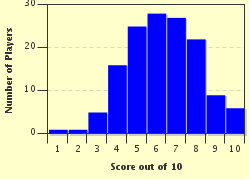Quiz Answer Key and Fun Facts
1. Birds of prey are known to have which type of vision?
2. Which of the following colors are dogs least likely to be able to perceive?
3. Why are goldfish so sensitive to changes in light?
4. What is the name of the reflective cells found in cats' eyes, that amplify incoming light?
5. Ocean dolphins have the ability to do which one of the following things with their eyes?
6. An ostrich's eyeball is larger than its brain.
7. Which animal has the largest eyeball in the ocean world?
8. Which of the following animals have corneas so similar to humans that they are sometimes used as human transplants?
9. Which of the following statements about an owl's eyes IS true?
10. Horses have a two blind spots: one in front of them and one in the rear.
Source: Author
dcpddc478
This quiz was reviewed by FunTrivia editor
guitargoddess before going online.
Any errors found in FunTrivia content are routinely corrected through our feedback system.

